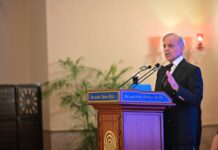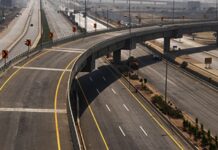The National Accounts Committee has revised the GDP growth rate for FY21 to 5.4% from 3.9% as per provisional estimates, the highest in 14 years. In addition, the NAC has also approved rebasing GDP on 2015-2016 prices. This means that the previous GDP statistics were underestimated by around Rs 1.3 trillion or 11.3%.
The GDP size has increased to $346.7 billion in FY 21 compared to $298 billion stated earlier. This ranks Pakistan at 35th position in terms of world economies
As a result, the per capita income of the country has risen to $1,666 compared to $1,543; while the public debt to GDP ratio has reduced to 72% from 84%. The tax to GDP ratio has worsened going down to 9.5% compared to the earlier communicated 11%. The fiscal deficit has improved by 1% bringing it to 6.1%.
The value of the economy was estimated at Rs 27.4 trillion in 2015-16. That has now increased to Rs 30.5 trillion as per the Planning Ministry. What this means is the total goods and services produced in the economy in FY21 is now estimated at Rs 55.5 trillion. Despite the rebasing, the GDP clocking in at $356.7 billion is still lower than $257 billion witnessed in 2017-18.
What is GDP rebasing?
Every few years, the GDP of a country is rebased to keep up with the evolution of prices in the economy. It is the process of replacing an old base year with a more recent base year. What this means is aggregates at constant prices are recalculated in terms of more recent prices. This gives a reference point to which future values of the GDP are then compared to.
If we put this in simple terms, let’s say an economy makes only apples. In Year 1, it produced 10 apples priced at Rs 1 per apple. That makes the GDP Rs 10. 8 years laters, let’s say the economy makes 20 apples. With the old base, the GDP would be Rs 20. However, the prices of apples have gone up to Rs 1.5 per apple making the GDP worth Rs 30. With the old base, the GDP was understated by 50%. The new base accurately presents the economy.
GDP is rebased to capture the real and reliable estimates of GDP. The Gross Fixed Capital Formation (GFCF) is done by enlarging the sphere and coverage of macroeconomic data and estimates as per the guidelines of the System of National Accounts.
Rebasing the GDP allows Pakistani policy makers to use data that is a better representation. “With these measures, economy size will be more reflective of the ground realities. After rebasing, the change in economic indicators shows a mixed picture,” says Fahad Rauf, Head of Research at Ismail Iqbal Securities.
When was this last done?
Essentially, this should be done once every five years. Moreover, the international best practice includes introducing new accounting conventions, improved methods of estimation, and revised statistical classifications every decade.
The last rebasing of GDP was undertaken in 2005-6 while President Musharraf and Prime Minister Shaukat Aziz were in office. Prior to that, rebasing was done in 1999-2000 after a period of 20 years. The first rebasing/ linking was done in 1959-1960. The second, in 1980-81, the third in 1999-2000, fourth in 2005-06.
The National Accounts Committee also devised a mechanism to rebase the national accounts every 5 years. This means, another rebasing is likely to happen soon. Earlier, the World Bank (WB) had validated the overall methodology for conducting the rebasing exercise in Pakistan and had pointed out some deficiencies that could be worked on.
Rebasing of national accounts was difficult for PBS. The PBS has conducted 42 studies on various sectors of the economy to finalize weights on the basis of the latest data compiled in the fiscal year 2015-16. In the past, consultants in the private sector would undertake these surveys and studies on behalf of the PBS, however, this is the first time the PBS is carrying it out themselves. Therefore, the time taken to go forward with the rebasing is also due to the fact that thorough scrutiny of PBS methodology and output was done before granting approval for rebasing of national accounts.
Earlier, the Pakistan Bureau of Statistics rebased the LSM index to 2015-16 from 2005-6. This allowed for the weights of various sectors to change, and for the PBS to add garments, with a weight of 6%, as a category to the index.
What really is GDP and how is it calculated?
The Gross Domestic Product of a country has been one of the most discussed topics in our everyday activities. The initial basic concept of GDP was invented in the late 18 th century. However, it was later developed by an American economist in 1934 and accepted as the primary measure of an economy soon after in 1944. Most of us have a solid understanding of GDP and what it represents. In layman terms it is the total monetary value of all final goods and services that have been produced within the geographical boundaries of a country over a selected period.
There are three methods that are widely employed to ascertain this figure. The approaches are Production, Income and Expenditure. Each of these methods encompassesdifferent components; however, each of these methods should arrive at the same figure in theory.
Production/Output Approach:
Through this approach GDP is measured as the difference between the value of output less the value of goods and services used in producing these outputs during an accounting period. By the application of this approach economists arrive at the GDP by subtracting from the total value of production/output the cost of goods and services used in production; this is termed as intermediate consumption. After adjusting for taxes and subsidies the final figure of GDP is computed.
GDP = Output – Intermediate Consumption + Taxes on products – Subsidies on Products
Income Approach:
In basic terms this method relies heavily on the accounting reality that all the expenditures in an economy should be equal to the total income generated in an economy. In the application of this approach consideration is given to the costs incurred by the producer within his own operations, the compensation to employees, taxes (less subsidies) on production, consumption of fixed capital and operating surplus. All of these are expected toadd up to the GDP at market value.
GDP = Compensation of employees + Taxes – Subsidies + Gross Operating Surplus
Expenditure Approach:
In following this method attention is given to the final use of the output for private consumption, government consumption, capital formation (investment) and net of imports and exports. To elaborate further: this approach includes all consumer spending, government spending, business investment spending and the net of exports. Mathematically the resulting figure of GDP is equivalent to aggregate demand since it is calculated using the same formula.
GDP = Final Consumption + Gross Capital Formation + Exports – Imports
The next steps?
The next steps are obvious. Better digitization of data. In all honesty, PBS does a pretty decent job with data collection. However, the way it is uploaded isn’t ideal. In a world where charting tools, interactive databases, and exporting data into various file types exist, PBS still relies on PDFs.
Moreover, the government also needs to think beyond yearly GDP stats and start collecting stats on a quarterly basis. The more data nodes available, the more accurate the planning and coordination can be.
Finally, just saying that the rebasing will be done every 5 years is not enough. Actually going through with the process is important. Moreover, changing mechanisms and techniques and forgoing rigidity is essential, especially methods that understand the local economy better.

























Inter national gdp health strykchers education & busnieses ideas masters means 5 years old Childrens world means heath+educations+foods cost gold rules means world sikurti busniess countri 2 countri
Good for Pakistan, May Allah Bless us.
Nice information thanks bro
Great work
Hi
Good information
Kindly visit my website i have thousands of free SVG files and free theme, Plugins
freesvg.uk